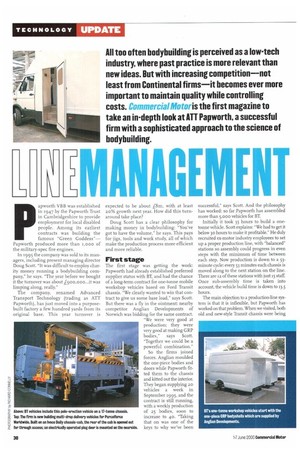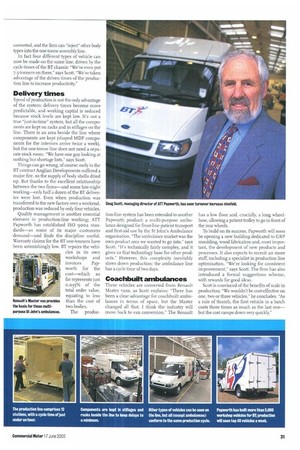ANAGE ENT
Page 32

Page 33

If you've noticed an error in this article please click here to report it so we can fix it.
papworth VBB was established in 1947 by the Papworth Trust in Cambridgeshire to provide employment for local disabled people. Among its earliest contracts was building the famous "Green Goddess"Papworth produced more than 1,000 of the military-spec fire engines.
In i9 95 the company was sold to its managers, including present managing director Doug Scott. "It was difficult to employ charity money running a bodybuilding company," he says. "The year before we bought it the turnover was about L9oo,000...it was limping along, really."
The company, renamed Advanced Transport Technology (trading as ATT Papworth), has just moved into a purposebuilt factory a few hundred yards from its original base. This year turnover is expected to be about gm, with at least zo% growth next year. How did this turnaround take place?
Doug Scott has a clear philosophy for making money in bodybuilding: "You've got to have the volume," he says. This pays for jigs, tools and work study, all of which make the production process more efficient and more reliable.
First stage
The first stage was getting the work: Papworth had already established preferred supplier status with BT, and had the chance of a long-term contract for one-tonne mobile workshop vehicles based on Ford Transit chassis. "We clearly wanted to win that contract to give us some base load," says Scott. But there was a fly in the ointment: nearby competitor Anglian Developments of Norwich was bidding for the same contract. "We were very good at production; they were very good at making GRP bodies," says Scott. "Together we could be a powerful combination."
So the firms joined forces. Anglian moulded the one-piece bodies and doors while Papworth fitted them to the chassis and idtted out the interior. They began supplying 20 vehicles a week in September 1995. and the contract is still running, with a weekly production of 25 bodies, soon to increase to 40. "Taking that on was one of the keys to why we've been
successful," says Scott. And the philosophy has worked: so far Papworth has assembled more than 5,000 vehicles for BT.
Initially it took 35 hours to build a onetonne vehicle. Scott explains; "We had to get it below 30 hours to make it profitable." He duly recanted ex-motor industry employees to set up a proper production line, with "balanced" stations so assembly could progress in even steps with the minimum of time between each step. Now production is down to a 53minute cycle: every 53 minutes each chassis is moved along to the next station on the line. There are 12 of these stations with just 15 staff. Once sub-assembly time is taken into account, the vehicle build time is down to 13.5 hours.
The main objection to a production-line system is that it is inflexible, but Papworth has worked on that problem. When we visited, both old and new-style Transit chassis were being converted, and the firm can "inject" other body types into the one-tonne assembly line.
In fact four different types of vehicle can now be made on the same line, driven by the cycle times of the BT chassis: "We've even put 7.5-tonners on there," says Scott. "We've taken advantage of the driven times of the production line to increase productivity."
Delivery times
Speed of production is not the only advantage of the system: delivery times become more predictable, and working capital is reduced because stock levels are kept low. It's not a true "just-in-time" system, but all the components are kept on racks and in stillages on the line. There is an area beside the line where components are kept (shaped MDF components for the interiors arrive twice a week), but the one-tonne line does not need a separate stock room. "We have one guy looking at nothing but shortage lists," says Scott.
Things can go wrong, of course: early in the BT contract Anglian Developments suffered a major fire, so the supply of body shells dried up. But thanks to the excellent relationship between the two firms—and some late-night working—only half a dozen of the BT deliveries were lost. Even when production was transferred to the new factory over a weekend, production was reduced by only four vehicles.
Quality management is another essential element in production-line working; ATT Papworth has established ISO g 00 2 standards—as some of its major customers demand—and finds the discipline useful. Warranty claims for the BT one-tonners have been astonishingly low. BT repairs the vehicles in its own workshops and
invoices Papworth for the cost—which so far represents just 0.035% of the total order value, equating to less Renault's Master van provides than the cost of the basis for these multitwo bodies.
purpose St John's ambulances. The produc
tion-line system has been extended to another Papworth product: a multi-purpose ambulance designed for front-line patient transport and first-aid use by the St John's Ambulance organisation. "The ambulance market was the own-product area we wanted to go into," says Scott. "It's technically fairly complex, and it gives us that technology base for other products." However, this complexity inevitably slows down production: the ambulance line has a cycle time of two days.
Coachbuilt ambulances
These vehicles are converted from Renault Master vans, as Scott explains: "There has been a clear advantage for coachbuilt ambulances in terms of space, but the Master changed all that. I think the industry will move back to van conversion." The Renault has a low floor and, crucially, a long wheelbase, allowing a patient trolley to go in front of the rear wheels.
To build on its success, Papworth will soon be opening a new building dedicated to GRP moulding, wood fabrication and, most important, the development of new products and processes. It also expects to recruit zo more staff, including a specialist in production line optimisation. "We're looking for consistent improvement," says Scott. The firm has also introduced a formal suggestions scheme, with rewards for good ideas.
Scott is convinced of the benefits of scale in production: "We wouldn't be cost-effective on one, two or three vehicles," he concludes. "As a rule of thumb, the first vehicle in a batch costs three times as much as the last one— but the cost ramps down very quickly."








































































































